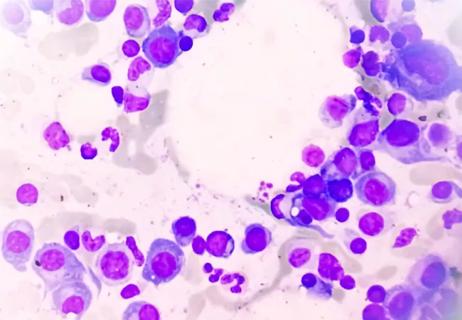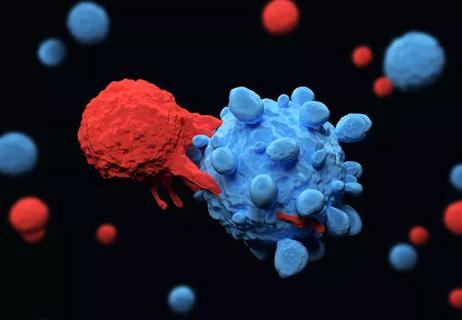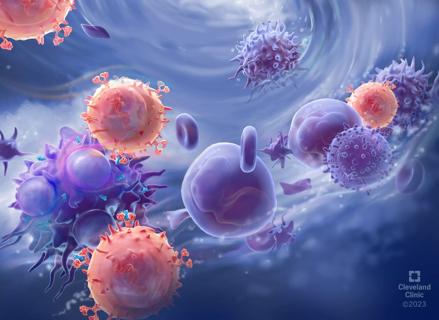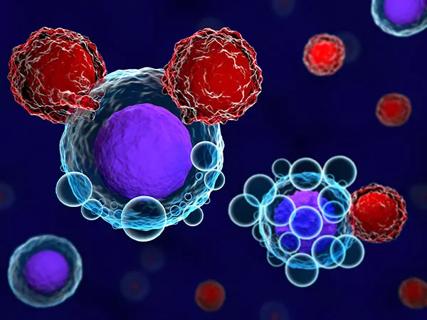Age alone should not rule out patients from potentially curative treatment

One-third of patients with diffuse large B-cell lymphoma (DLBCL) and follicular lymphoma are diagnosed in their 70s or older, yet these patients are often not included in clinical trials for CAR T-cell therapy. To address this gap, researchers conducted a multicenter retrospective study of CD19-directed CAR T-cell therapy for patients who were 80 or older.
Advertisement
Cleveland Clinic is a non-profit academic medical center. Advertising on our site helps support our mission. We do not endorse non-Cleveland Clinic products or services. Policy
Older patients with refractory disease may be prescribed chemotherapy or polatuzumab vedotin in the second-line setting or bispecific antibodies in the third-line setting. However, none of these options are curative. Currently, CAR T-cell therapy is the only potentially curative option for refractory B-cell lymphoma.
“In most cases, older patients were excluded from CAR T-cell therapy trials due to medical comorbidities or suboptimal functional status,” says Deepa Jagadeesh, MD, a staff physician in the Hematology and Medical Oncology department at Cleveland Clinic Cancer Institute. “We wanted to understand how these patients fared on this emerging treatment.”
For the study, researchers reviewed patient records from 16 cancer centers across the country to identify 80+ year-old patients who had received a CD19-directed CAR T-cell therapy for relapsed/refractory (R/R) B-cell lymphoma between January 1, 2018 and December 31, 2023.
Of the 88 patients in the study, the median age was 82 years, with 68.2% being patients with diffuse large B-cell lymphoma (DLBCL). The remaining patients had transformed follicular lymphoma (tFL) 18.2% and mantle cell lymphoma (MCL) 10.2%. Twenty-four percent of patients had double-hit lymphoma (double-hit DLBCL).
Nearly half of the patients received axicabtagene ciloleucel (axi-cel), with the remaining patients receiving brexucabtagene, lisocabtagene maraleucel (liso-cel) or tisagenlecleucel (CTL019).
End points included the incidence of adverse events such as cytokine release syndrome (CRS) and immune effector cell-associated neurotoxicity syndrome (ICANS). The researchers also studied the rate of infections, readmission rates, objective and complete response rates and incidents of relapse. The study also looked at progression-free and overall survival.
Advertisement
More than 70 percent of evaluable patients achieved a complete response, and 17.9% achieved a partial response. The 12-month survival in patients with DLBCL or tFL was 47.6%, and the 12-month survival in patients with MCL was 45%.
“The study demonstrated that CAR T-cell therapy is feasible in patients 80 and older,” says Dr. Jagadeesh. “The one-year progression-free survival was close to 50%, which is very encouraging. This is a reminder to physicians not to use age as a single exclusion criterion. CAR T-cell therapy can produce effective, long-term remission in many patients in their 80s.”
The toxicity of the therapy was also comparable to that of younger patients. Although more than 77% of patients experienced CRS, only 7.4% of these were grades 3-4, with a median duration of symptoms being three days. Fifty-eight percent of patients developed ICANS, with 31.4% of those being grade 3-4, with a median duration of symptoms being six days.
The majority of patients with CRS received tocilizumab, and the majority of patients experiencing ICANS received dexamethasone. “It’s reassuring to see that more physicians are aware of the potential toxicities and are being proactive in treating them,” says Dr. Jagadeesh.
Nearly a quarter of patients did require readmission to the hospital in the first 100 days after receiving CAR T-cell therapy. Some of the reasons for readmittance included recurrence of CRS or ICANS, failure to thrive, atrial fibrillation or infection.
Although the recurrence of CRS and ICANS is not common, Dr. Jagadeesh notes that her team has observed some late-onset cases. “We want to keep these in mind when patients present with symptoms. CRS is also less common with certain products, so we take this into consideration when choosing the CAR T-cell product if we have a patient who is frailer.”
Advertisement
The study highlighted several notable findings.
CAR T-cell therapy can be safely administered to patients 80 years of age or older. The efficacy rates in the study were similar to those in younger patients. The study authors did caution that incorporating frailty assessment tools is beneficial in identifying octogenarian patients for CAR T-cell therapy.
Timing is crucial. For many patients, swift initiation of second- or third-line therapy is essential. “It’s important for community physicians to reach out to refer patients for CAR T-cell therapy evaluation early,” says Dr. Jagadeesh. “Earlier referral would allow CAR T-cell centers to evaluate if the patient is eligible for such therapy, as it offers the potential for a cure.”
A multidisciplinary team is critical for patients with comorbidities. Comorbidities won’t necessarily rule a patient out as a candidate for CAR T-cell therapy, but they do require additional supportive measures. For example, patients experiencing CRS receive fluids, which can exacerbate preexisting heart failure. If a patient has a heart condition, the team should engage a cardiologist up front to consult on the case.
Similarly, it can be challenging to manage blood sugars in patients with diabetes if they need steroid treatment for ICANS. Involving an endocrinologist is advantageous in those cases to help manage toxicities.
Gaps still remain in access to CAR T-cell therapy. Hopefully as the therapy becomes available at more locations and increasingly is used on an outpatient basis this will remove some barriers.“There has been an explosion of new treatments for diffuse large B-cell lymphoma,” says Dr. Jagadeesh. “We need to be considering each of these at the correct time, and ensure all patients who are eligible have access to appropriate treatment.”
Advertisement
Dr. Jagadeesh noted the need for larger databases and longer-term outcomes to build on these findings. Additionally, there is a need to understand what barriers patients face in receiving CAR T-cell therapy.
Advertisement
Advertisement

Higher type 2 immunity observed in persistent CAR T cells

Real-world study shows high response rates that are durable with commercial lisocabtagene maraleucel

Minimal residual disease testing shows promising results

Dispelling myths and sharing practical experiences

Early results show patients experiencing deep and complete response

Advancements lead to a new trial involving autoimmune disease

Two thirds of patients responded to CAR T-cell therapy

Research indicates strong rationale for expanding trial eligibility criteria